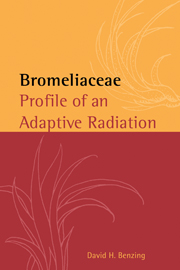Book contents
- Frontmatter
- Contents
- List of contributors
- Preface
- Acknowledgments
- Glossary
- Abbreviations
- Part one Brief overview
- Part two Basic structure, function, ecology and evolution
- Part three Special topics
- 10 Neoregelia subgenus Hylaeaicum
- 11 Cryptanthus
- 12 Tillandsioideae
- 13 Tillandsia and Racinaea
- 14 Ethnobotany of Bromeliaceae
- 15 Endangered Bromeliaceae
- Literature cited
- Name index
- Subject index
- Taxon index
12 - Tillandsioideae
from Part three - Special topics
Published online by Cambridge University Press: 19 January 2010
- Frontmatter
- Contents
- List of contributors
- Preface
- Acknowledgments
- Glossary
- Abbreviations
- Part one Brief overview
- Part two Basic structure, function, ecology and evolution
- Part three Special topics
- 10 Neoregelia subgenus Hylaeaicum
- 11 Cryptanthus
- 12 Tillandsioideae
- 13 Tillandsia and Racinaea
- 14 Ethnobotany of Bromeliaceae
- 15 Endangered Bromeliaceae
- Literature cited
- Name index
- Subject index
- Taxon index
Summary
Tillandsioideae are mostly rosulate herbs characterized by entire leaf margins, radially organized peltate trichomes (Fig. 2.7), usually superior (or nearly so) ovaries, and three-parted capsules that contain plumoseappendaged seeds (Fig. 3.6J;Wittmack 1888; Baker 1889; Mez 1894, 1896, 1934–35; Harms 1930; Smith and Downs 1977; Rauh 1990). Stigma morphology varies more than in the other two subfamilies, with at least five different types present (Brown and Gilmartin 1989b; Gortan 1991; Figs. 3.1C, 12.1). Pollen morphology is similarly variable (Fig. 12.2). Grains are predominantly sulcate with a distal germination region, and represent the diffuse sulcus, insulae-type, operculum-type and Vriesea imperialis-type (Halbritter 1992). Catopsis is exceptional with its simple sulcus, while inaperturate pollen occurs in some Guzmania species. This subfamily comprises the genera Alcantarea (16 spp.), Catopsis (21 spp.), Glomeropitcairnia (2 spp.), Guzmania (176 spp.), Mezobromelia (9 spp.), Racinaea (56 spp.), Tillandsia (551 spp.), Vriesea (187 spp.) and Werauhia (73 spp.) (Smith and Downs 1977; Utley 1983; Till 1984, 1992b, 1995; Kiff 1991; Grant 1993a,b, 1994a,b, 1995a,b; Spencer and Smith 1993; Luther and Sieff 1996; Till et al. 1997).
- Type
- Chapter
- Information
- BromeliaceaeProfile of an Adaptive Radiation, pp. 555 - 572Publisher: Cambridge University PressPrint publication year: 2000
- 3
- Cited by



